Enhancing Regional Tourism Development in the Protected Areas Using the Total Economic Value Approach
Abstract
:1. Introduction
2. Materials and Methods
2.1. Study Area
2.2. Research Method
2.2.1. Stage (I): Identify the Tourism Hiking Trails in Abu Qubies Protected Area
2.2.2. Stage (II): Valuation of Abu Qubies Protected Area Ecosystem Services
3. Results
3.1. Use Value in Abu Qubies Protected Area
3.1.1. Direct Use Value
3.1.2. Indirect Use Value
3.1.3. Optional Value
3.2. Non-Use Value in Abu Qubies Protected Area
3.2.1. Existence Value
3.2.2. Bequest Value
3.3. Classification of Tourism Hiking Trails in Abu Qubies Protected Area Based on TEV Approach
4. Discussion
5. Conclusions
6. Limitations and Future Research
Author Contributions
Funding
Data Availability Statement
Acknowledgments
Conflicts of Interest
References
- IUCN. The World Now Protects 15% of Its Land, but Crucial Biodiversity Zones Left Out. Available online: https://www.iucn.org/news/secretariat/201609/world-now-protects-15-its-land-crucial-biodiversity-zones-left-out (accessed on 22 December 2021).
- UNEP-WCMC; IUCN. Protected Planet Report 2016; Protected Planet Reports; UNEP: Cambridge, UK; Gland, Switzerland, 2016; p. 84. [Google Scholar]
- WCPA; IUCN. Economic Values of Protected Areas: Guidelines for Protected Area Managers; Best Practice Protected Area Guidelines Series; IUCN Publications Services Unit: Cambridge, UK; Gland, Switzerland, 1998; ISBN 2-8317-0461-8. [Google Scholar]
- Eagles, P.; McCool, S.; Haynes, C. Sustainable Tourism in Protected Areas: Guidelines for Planning and Management; Best Practice Protected Area Guidelines Series; IUCN—The World Conservation Union: Gland, Switzerland; Cambridge, UK, 2002; ISBN 2-8317-0648-3. [Google Scholar]
- Whitelaw, P.A.; King, B.E.M.; Tolkach, D. Protected Areas, Conservation and Tourism—Financing the Sustainable Dream. J. Sustain. Tour. 2014, 22, 584–603. [Google Scholar] [CrossRef]
- Wilson, E.; Nielsen, N.; Buultjens, J. From Lessees to Partners: Exploring Tourism Public–Private Partnerships within the New South Wales National Parks and Wildlife Service. J. Sustain. Tour. 2009, 17, 269–285. [Google Scholar] [CrossRef]
- IUCN. Guidelines for Protected Area Management Categories; IUCN: Cambridge, UK; Gland, Switzerland, 1994; ISBN 2-8317-0201-1. [Google Scholar]
- Bushell, R.; Bricker, K. Tourism in Protected Areas: Developing Meaningful Standards. Tour. Hosp. Res. 2017, 17, 106–120. [Google Scholar] [CrossRef]
- Kc, B. Complexity in Balancing Conservation and Tourism in Protected Areas: Contemporary Issues and Beyond. Tour. Hosp. Res. 2021, 22, 146735842110158. [Google Scholar] [CrossRef]
- Lanier, P. The Positive Impacts of Ecotourism in Protected Areas; WIT Press: Opatija, Croatia, 8 July 2014; pp. 199–209. [Google Scholar]
- Kim, M.; Xie, Y.; Cirella, G.T. Sustainable Transformative Economy: Community-Based Ecotourism. Sustainability 2019, 11, 4977. [Google Scholar] [CrossRef] [Green Version]
- Koens, J.F.; Dieperink, C.; Miranda, M. Ecotourism as a Development Strategy: Experiences from Costa Rica. Environ. Dev. Sustain. 2009, 11, 1225–1237. [Google Scholar] [CrossRef] [Green Version]
- Mondino, E.; Beery, T. Ecotourism as a Learning Tool for Sustainable Development. The Case of Monviso Transboundary Biosphere Reserve, Italy. J. Ecotour. 2019, 18, 107–121. [Google Scholar] [CrossRef]
- United Nations. The 2030 Agenda for Sustainable Development. Available online: https://sdgs.un.org/goals (accessed on 13 January 2022).
- OECD. OECD Tourism Trends and Policies 2020; OECD Tourism Trends and Policies; OECD: Paris, France, 2020; ISBN 978-92-64-70314-8. [Google Scholar]
- UNWTO. 100% of Global Destenations Now Have COVID-19 Travel Restrictions, UNWTO Reports. Available online: https://www.unwto.org/news/covid-19-travel-restrictions (accessed on 13 January 2022).
- Spenceley, A.; McCool, S.; Newsome, D.; Báez, A.; Barborak, J.R.; Blye, C.-J.; Bricker, K.; Sigit Cahyadi, H.; Corrigan, K.; Halpenny, E.; et al. Tourism in Protected and Conserved Areas amid the COVID-19 Pandemic. PARKS 2021, 103–118. [Google Scholar] [CrossRef]
- Balmford, A.; Green, J.M.H.; Anderson, M.; Beresford, J.; Huang, C.; Naidoo, R.; Walpole, M.; Manica, A. Walk on the Wild Side: Estimating the Global Magnitude of Visits to Protected Areas. PLoS Biol. 2015, 13, e1002074. [Google Scholar] [CrossRef] [Green Version]
- Rodriges, A.; Kastenholz, E. Hiking as a Recreational and Tourist Activity—Comparing Portuguese Hikers with Those from Other Nationalities. Rev. Tur. Desenvolv. 2007, 7, 83–91. [Google Scholar]
- Li, W.; Ge, X.; Liu, C. Hiking Trails and Tourism Impact Assessment In Protected Area: Jiuzhaigou Biosphere Reserve, China. Environ. Monit. Assess 2005, 108, 279–293. [Google Scholar] [CrossRef] [PubMed] [Green Version]
- Newsome, D. The Collapse of Tourism and Its Impact on Wildlife Tourism Destinations. J. Tour. Futures 2021, 7, 295–302. [Google Scholar] [CrossRef]
- Mnguni, D.E.M. Community-Based Tourism Development: A Hiking Trails Perspective. Tour. Leis. 2017, 6, 17. [Google Scholar]
- Cole, D.N.; Petersen, M.E.; Lucas, R.C. Managing Wilderness Recreation Use: Common Problems and Potential Solutions; U.S. Department of Agriculture, Forest Service, Intermountain Research Station: Ogden, UT, USA, 1987; p. INT-GTR-230. [Google Scholar]
- Finnessey, L. The Negative Effects of Tourism on National Parks in the United States. Honors Theses. Bachelor’s Thesis, Johnson & Wales University, Wales, UK, 2012. [Google Scholar]
- Kavallinis, I.; Pizam, A. The Environmental Impacts of Tourism— Whose Responsibility Is It Anyway? The Case Study of Mykonos. J. Travel Res. 1994, 33, 26–32. [Google Scholar] [CrossRef]
- Stronza, A.L.; Hunt, C.A.; Fitzgerald, L.A. Ecotourism for Conservation? Annu. Rev. Environ. Resour. 2019, 44, 229–253. [Google Scholar] [CrossRef]
- MoAAR; The Ministry of State for Environment Affairs—MSEA. Abu Qubies Protected Area Management Plan “Biodiversity Conservation and Protected Area Management Project” SYR/05/010; The Ministry of State for Environment Affairs—MSEA: Damascus, Syria, 2010. [Google Scholar]
- GEF. GEF Country Portfolio Evaluation: Syria (1994–2008); Global Environment Facility Evaluation Office: Washington, DC, USA, 2009. [Google Scholar]
- Ministry of Local Administration and Environment. Accomplishments and Actions Taken in Connection with the Work of the Directorate of Biodiversity and Land. Available online: http://www.mola.gov.sy/mola/ (accessed on 18 April 2022).
- Martini, G. Forest Sector Policy and Institutional Development; Food and Agriculture Organization (FAO): Damascus, Syria, 2009. [Google Scholar]
- MoAAR. The Syrian Ministry of Agriculture and Agrarian Reform. Available online: http://moaar.gov.sy/main/archives/19575 (accessed on 13 January 2022).
- UNDP; GEF. Biodiversity Conservation & Protected Area Management (PIMS 227); UNDP: Damascus, Syria, 2014. [Google Scholar]
- Ilieș, D.C.; Hodor, N.; Indrie, L.; Dejeu, P.; Ilieș, A.; Albu, A.; Caciora, T.; Ilieș, M.; Barbu-Tudoran, L.; Grama, V. Investigations of the Surface of Heritage Objects and Green Bioremediation: Case Study of Artefacts from Maramureş, Romania. Appl. Sci. 2021, 11, 6643. [Google Scholar] [CrossRef]
- Yazbek, A. A Study of the Distribution of Forest Cover in (Abu Qubais) Reserve Using Remote Sensing Techniques (RS) and Geographic Information Systems (GIS). Unpublished. Master Thesis, Damascus University, College of Agriculture, Department of Renewable Natural Resources and Environment, Damascus, Syria, 2011. [Google Scholar]
- Syrian Society for the Conservation of Wildlife (SSCW). Wildlife for People. Available online: https://sscw-syr.org/ (accessed on 18 April 2022).
- GEF; UNDP; Ministry of State for Environmental Affairs. The Fourth National Report on Biodiversity in the Syrian Arab Republic; UNDP: Damascus, Syria, 2009. [Google Scholar]
- Lette, H.; de Boo, H. Economic Valuation of Forests and Nature—A Support Tool for Effective Decision-Making; International Agricultural Centre (IAC): Ede, The Netherlands, 2002. [Google Scholar]
- Dushin, A.V.; Yurak, V.V. Total Economic Value Concept: Essence, Evolution and Author’s Approach. In Proceedings of the International Scientific Conference “Far East Con” (ISCFEC 2018), Vladivostok, Russia, 2–4 October 2018; Atlantis Press: Vladivostok, Russia, 2019. [Google Scholar]
- Defra. An Introductory Guide to Valuing Ecosystem Services; Department for Environment, Food and Rural Affairs: London, UK, 2011; p. 68. [Google Scholar]
- Aanesen, M.; Armestrong, C.; Kahui, V. TEV (Total Economic Value) Analysis of a Marine Environment in Norway. In Proceedings of the Montpellier Proceedings, Montpellier, France, 13–16 July 2010; International Institute of Fisheries Economics and Trade (IIFET): Montpellier, France, 2010; p. 11. [Google Scholar]
- Tinch, R.; Beaumont, N.; Sunderland, T.; Ozdemiroglu, E.; Barton, D.; Bowe, C.; Börger, T.; Burgess, P.; Cooper, C.N.; Faccioli, M.; et al. Economic Valuation of Ecosystem Goods and Services: A Review for Decision Makers. J. Environ. Econ. Policy 2019, 8, 359–378. [Google Scholar] [CrossRef]
- Pascual, U.; Termansen, M.; Hedlund, K.; Brussaard, L.; Faber, J.H.; Foudi, S.; Lemanceau, P.; Jørgensen, S.L. On the Value of Soil Biodiversity and Ecosystem Services. Ecosyst. Serv. 2015, 15, 11–18. [Google Scholar] [CrossRef]
- Mainstreaming the Economics of Nature: A Synthesis of the Approach, Conclusions and Recommendations of Teeb; UNEP (Ed.) The Economics of Ecosystems & Biodiversity; UNEP: Geneva, Switzerland, 2010; ISBN 978-3-9813410-3-4. [Google Scholar]
- Croci, E.; Lucchitta, B.; Penati, T. Valuing Ecosystem Services at the Urban Level: A Critical Review. Sustainability 2021, 13, 1129. [Google Scholar] [CrossRef]
- Nature Conservancy; World Bank; IUCN. How Much Is an Ecosystem Worth?—Assesssing the Economic Value of Conservation; World Bank: Washington, DC, USA, 2004. [Google Scholar]
- Ghermandi, A.; Nunes, P.A.L.D.; Portela, R.; Rao, N.; Teelucksingh, S.S. 12.11—Recreational, Cultural, and Aesthetic Services from Estuarine and Coastal Ecosystems. In Treatise on Estuarine and Coastal Science; Wolanski, E., McLusky, D., Eds.; Academic Press: Waltham, MA, USA, 2011; pp. 217–237. ISBN 978-0-08-087885-0. [Google Scholar]
- National Academies of Sciences; Engineering; Medicine. Valuing Climate Changes: Updating Estimation of the Social Cost of Carbon Dioxide; National Academies Press: Washington, DC, USA, 2017; p. 24651. ISBN 978-0-309-45420-9. [Google Scholar]
- Ricke, K.; Drouet, L.; Caldeira, K.; Tavoni, M. Country-Level Social Cost of Carbon. Nat. Clim. Change 2018, 8, 895–900. [Google Scholar] [CrossRef]
- Anthoff, D.; Tol, R.S.J. The Uncertainty about the Social Cost of Carbon: A Decomposition Analysis Using Fund. Clim. Change 2013, 117, 515–530. [Google Scholar] [CrossRef]
- Venkatachalam, L. The Contingent Valuation Method: A Review. Environ. Impact Assess. Rev. 2004, 24, 89–124. [Google Scholar] [CrossRef]
- ArcGIS Pro. How the Zonal Statistics Tools Work. Available online: https://pro.arcgis.com/en/pro-app/2.8/tool-reference/spatial-analyst/how-zonal-statistics-works.htm (accessed on 20 April 2022).
- Nassour, Y. Interview with the Director of Abu Qubies Protected Area; Latakia, Syria, 2021. [Google Scholar]
- Ministry Of Agriculture and Agrarian. Reform Statistical Group—Price List. Available online: http://moaar.gov.sy/main/archives/24005 (accessed on 18 April 2022).
- Abu Qubies. Protected Area—Field Observation, 2021.
- OECD Quasi Option Value. In Cost-Benefit Analysis and the Environment; OECD: Paris, France, 2006; pp. 145–154. ISBN 978-92-64-01004-8.
- Russo, G.; Beritognolo, I.; Bufacchi, M.; Stanzione, V.; Pisanelli, A.; Ciolfi, M.; Lauteri, M.; Brush, S.B. Advances in Biocultural Geography of Olive Tree (Olea Europaea L.) Landscapes by Merging Biological and Historical Assays. Sci. Rep. 2020, 10, 7673. [Google Scholar] [CrossRef] [PubMed]
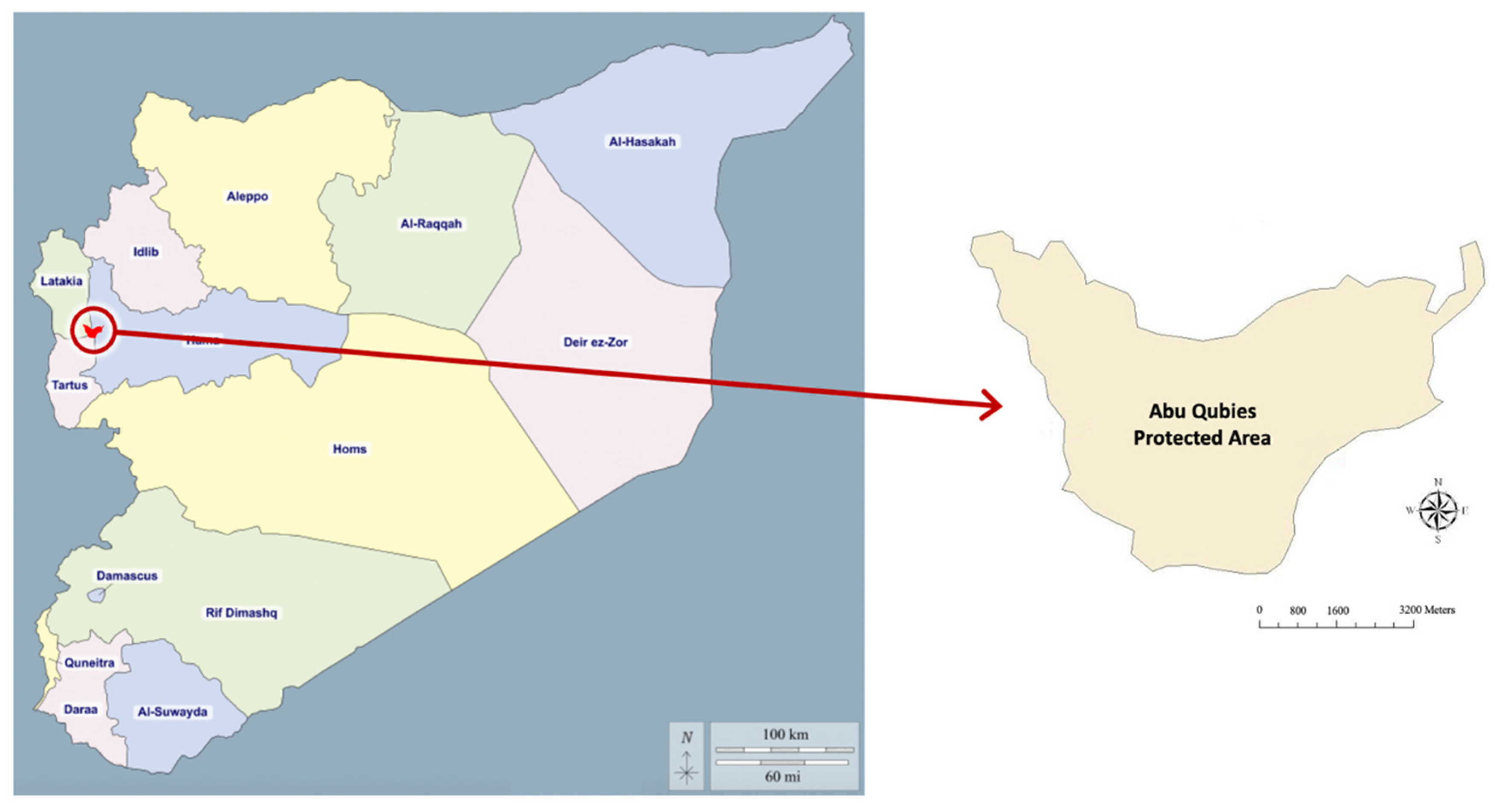



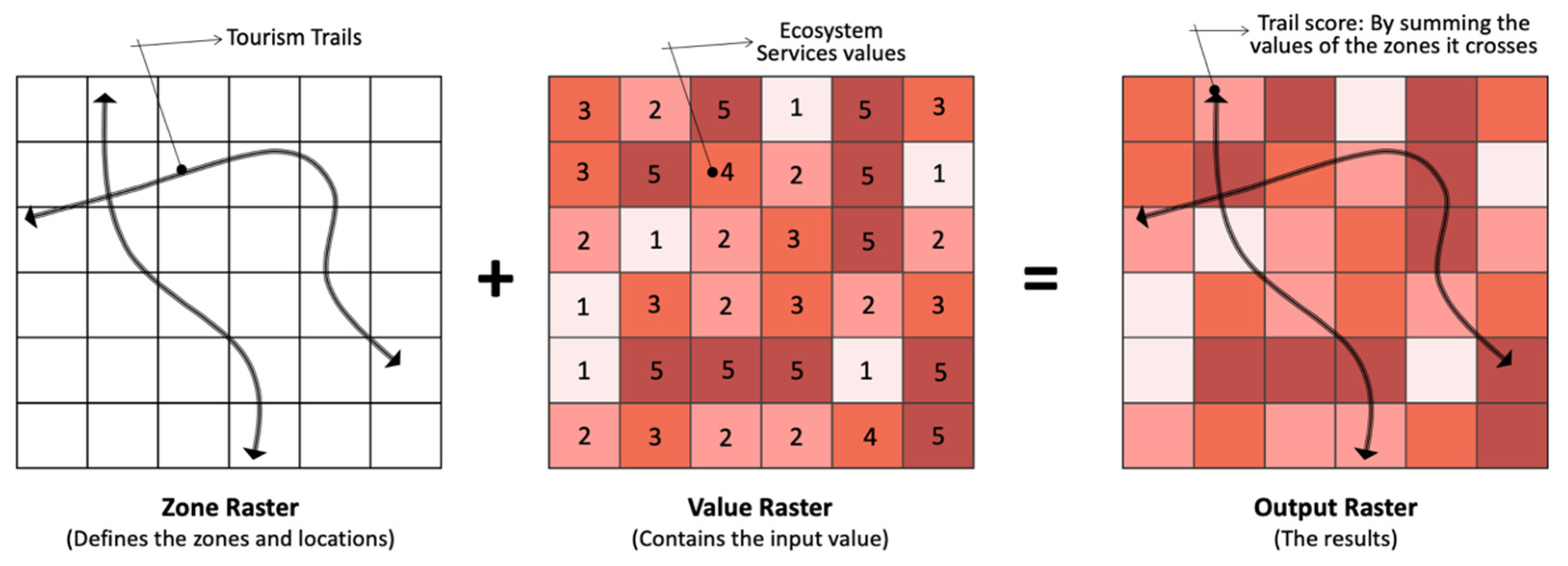
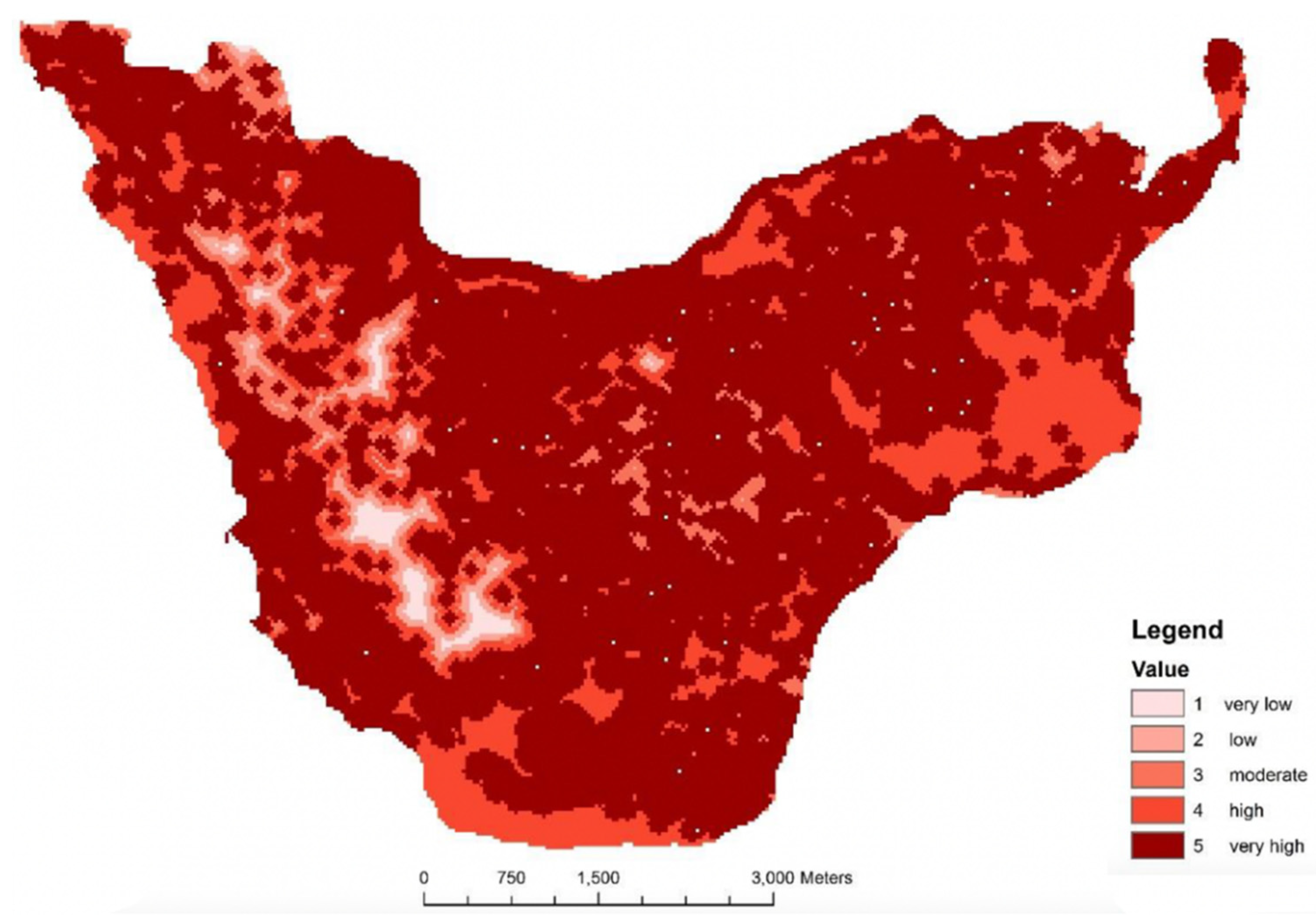
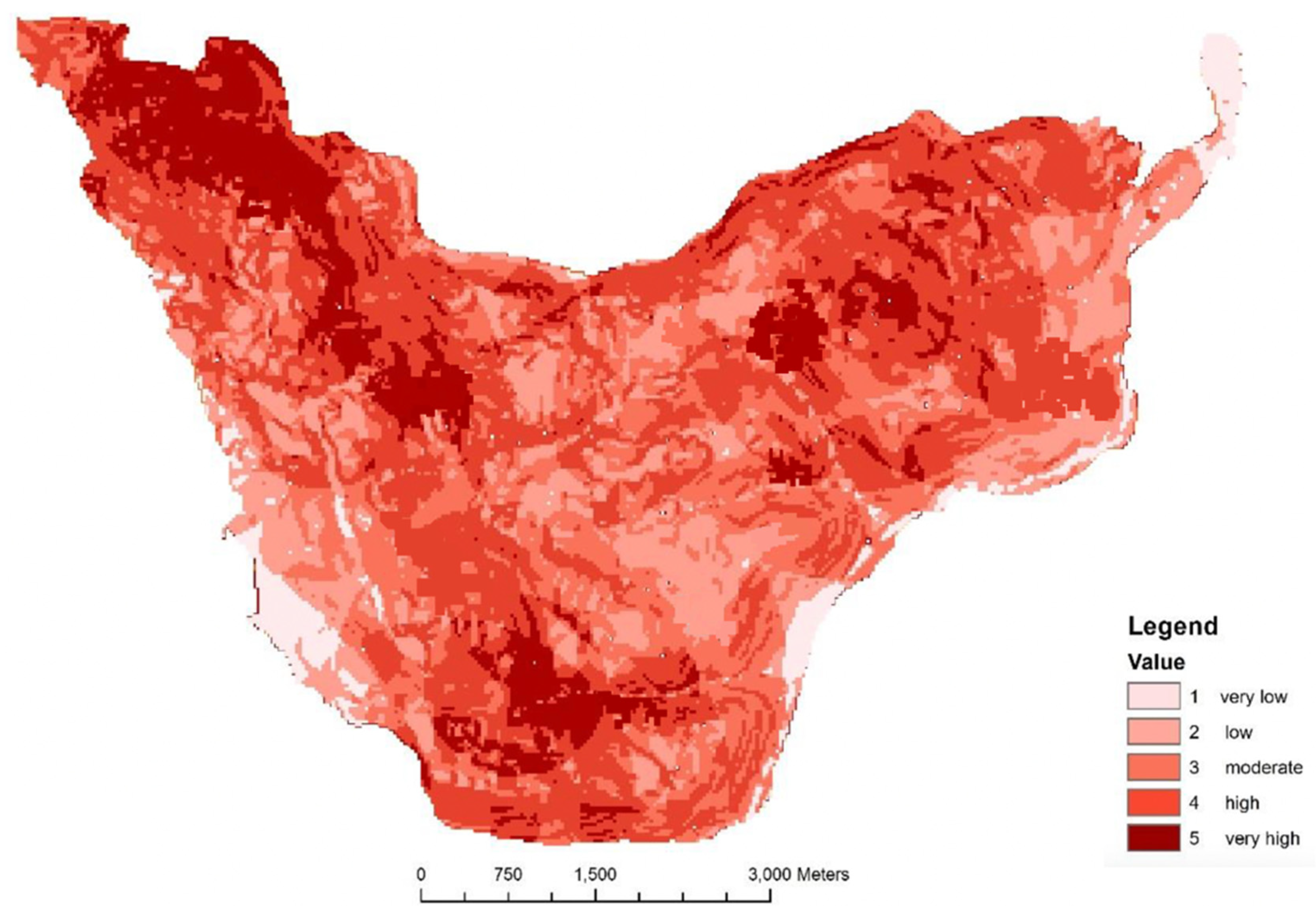
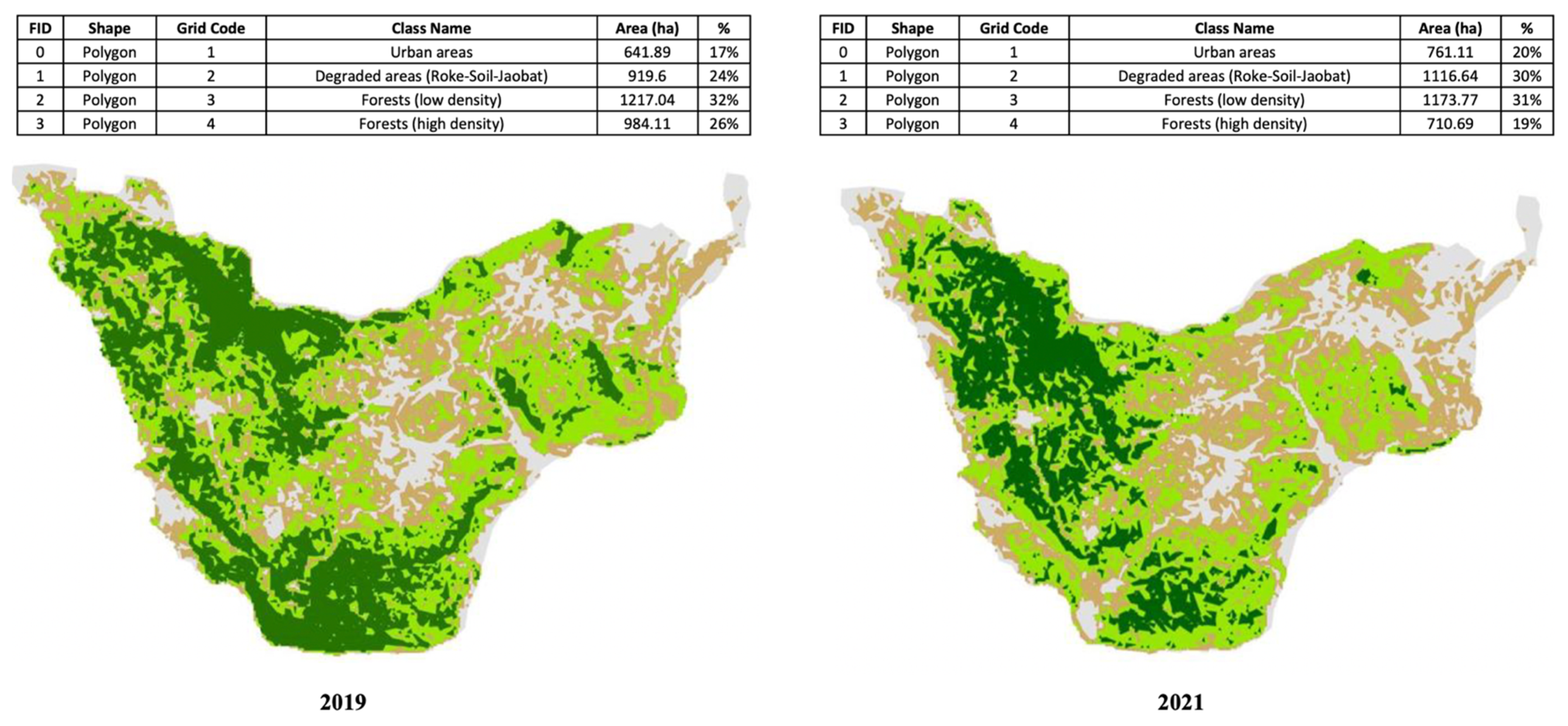
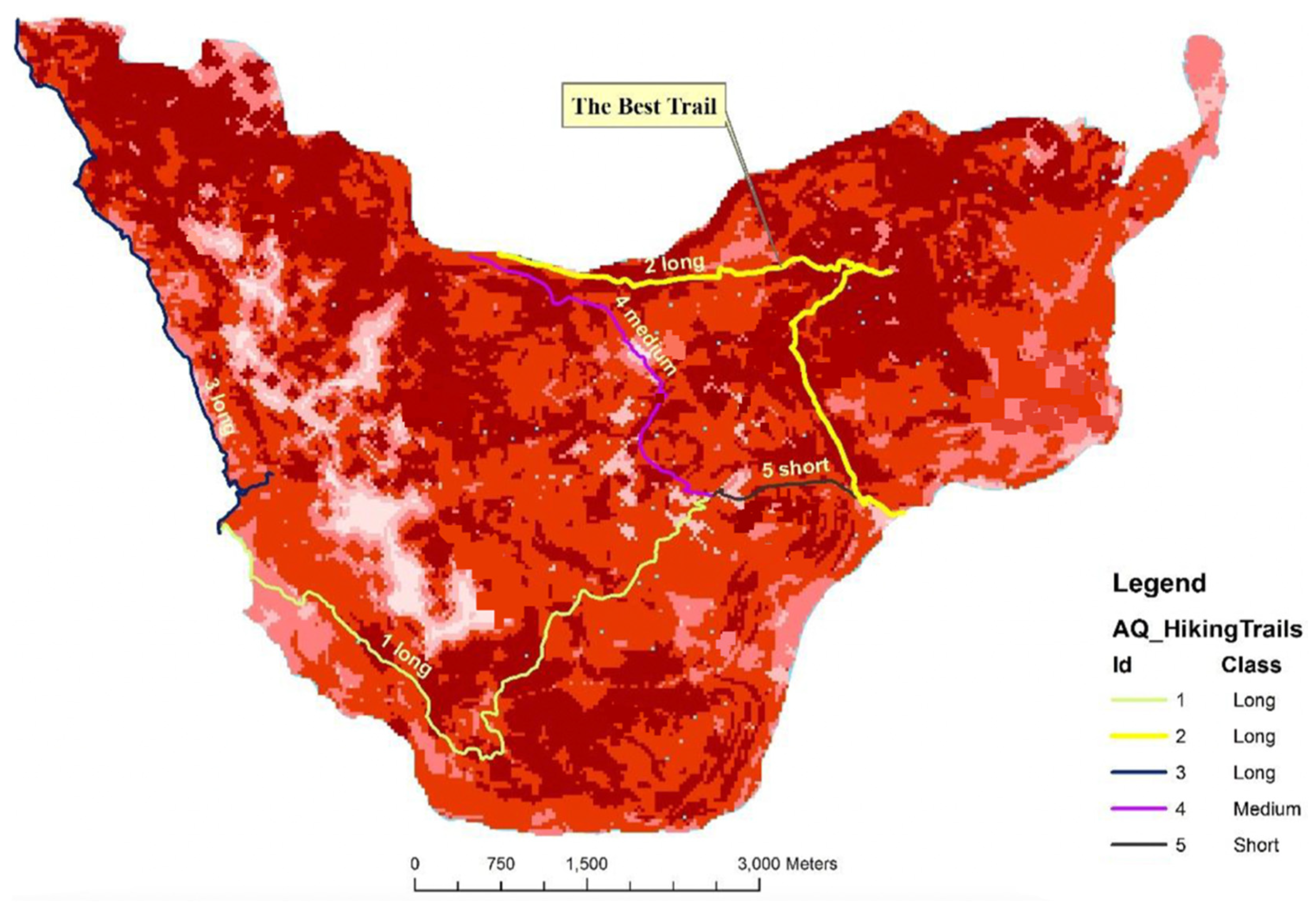

| TEV Approach Classification (Use Value) | Valuation | Measurement Method | |||||
|---|---|---|---|---|---|---|---|
| Value Classification | Category | Good/Service | Monetary Value ($/year) | Total ($/year) | % | ||
| Use Value | Direct Value | Wood Products | Hardwood/Firewood and fruit trees | 203,620.76 | 235,543.81 | 8.77 | Market Price |
| Non-wood Products | Honey and Thymus syriacus | 5961.44 | |||||
| Laurus nobilis and Orchids (plants) | 25,961.61 | ||||||
| Indirect Value | Environmental Dimension | Carbon reduction | 2,450,000 | 2,450,000 | 91.23 | Social Cost of Carbon (SCC) | |
| Optional Value | Not estimated | ||||||
| Total Valuation of Use Value in Abu Qubies Syrian Protected Area | 2,685,543.81 | 100 | |||||
| TEV Approach Classification (Non-Use Value) | Valuation | Measurement Method | |||||
|---|---|---|---|---|---|---|---|
| Value Classification | Category | Good/Service | Monetary Value (Per Year) | Total ($/Year) | % | ||
| Non-use Value | Existence Value | Willingness to pay | The existence of unique animals and birds species | 77,220 | 77,220 | 39.2 | CVM |
| Bequest Value | Willingness to pay | Combat poaching, excessive logging and soil degradation | 119,340 | 119,340 | 60.8 | ||
| Total Valuation of Non-use Value in Abu Qubies Syrian Protected Area | 196,560 | 100 | |||||
| ID | Tourism Hiking Trail | Length (km) | Mean | Median | Minority | Majority | Total Score |
|---|---|---|---|---|---|---|---|
| 1 | Sheikh Ali Majdal—Beer Eljabal | 7.77 | 4.4 | 4 | 2 | 4 | 1339 |
| 2 | Abu Qubies—Mshta Elbeer | 6.89 | 4.7 | 5 | 3 | 5 | 1463 |
| 3 | Ras Alshareh—Sheikh Hatem | 6.34 | 3.1 | 4 | 2 | 3 | 591 |
| 4 | Sheikh Abdullah—Beer Eljabal | 3.93 | 3.9 | 4 | 1 | 4 | 703 |
| 5 | Abu Qubies—Beer Eljabal | 1.44 | 2.5 | 3 | 3 | 4 | 273 |
Publisher’s Note: MDPI stays neutral with regard to jurisdictional claims in published maps and institutional affiliations. |
© 2022 by the authors. Licensee MDPI, Basel, Switzerland. This article is an open access article distributed under the terms and conditions of the Creative Commons Attribution (CC BY) license (https://creativecommons.org/licenses/by/4.0/).
Share and Cite
Kabil, M.; Alayan, R.; Lakner, Z.; Dávid, L.D. Enhancing Regional Tourism Development in the Protected Areas Using the Total Economic Value Approach. Forests 2022, 13, 727. https://doi.org/10.3390/f13050727
Kabil M, Alayan R, Lakner Z, Dávid LD. Enhancing Regional Tourism Development in the Protected Areas Using the Total Economic Value Approach. Forests. 2022; 13(5):727. https://doi.org/10.3390/f13050727
Chicago/Turabian StyleKabil, Moaaz, Rahaf Alayan, Zoltán Lakner, and Lóránt Dénes Dávid. 2022. "Enhancing Regional Tourism Development in the Protected Areas Using the Total Economic Value Approach" Forests 13, no. 5: 727. https://doi.org/10.3390/f13050727
APA StyleKabil, M., Alayan, R., Lakner, Z., & Dávid, L. D. (2022). Enhancing Regional Tourism Development in the Protected Areas Using the Total Economic Value Approach. Forests, 13(5), 727. https://doi.org/10.3390/f13050727









